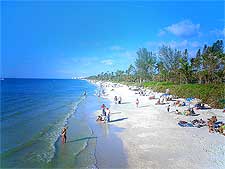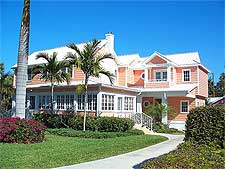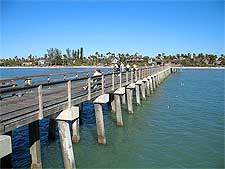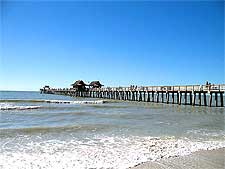Naples History Facts and Timeline
(Naples, Florida - FL, USA)

The Caloosa tribe first migrated to present day Naples, Florida, in search of warmer weather towards the end of the last glacial period. Europeans did not follow suit until Spanish explorer Juan Ponce de Leon's last voyage along the coast of southwest Florida in 1521.
At this point in Naples history, the Caloosa killed Ponce de Leon and drove the Spaniards away. Remnants of Caloosa culture are displayed at the Collier County Museum on the Tamiami Trail.
Gordon and Wiggins
Until the late 1860s, most people in the Naples area belonged to the Caloosa or Seminole tribes. Two European settlers, Joe Wiggins and Roger Gordon, were the first people in centuries to stay here. This part of southwest Florida was often compared to southern Italy for its abundant wildlife and sunny climate. Naples received its name after promoters described its bay as being superior to the one in its namesake Italian city.

Winter Resort
Local 20th-century history was really shaped when the town and its surrounding area became the property of Walter N. Haldeman and other wealthy Kentucky businessmen in 1887. The pier jutting into the Gulf of Mexico has maintained its unique T-form after three different reconstructions through the years. The region's oldest house, Palm Cottage, has stood on the pier since 1895, while the Naples Commissary Building dates back to 1903.

Collier County
The Naples area attracted a fair number of winter visitors during the early 20th century, including US President Teddy Roosevelt. However, entrepreneur Barron Gift Collier did not officially found the Florida county, which bears his name and includes Naples, until 1923. Another early settler, Ed Frank, established the area's first car dealership. Frank also constructed the first strip mall and invented the swamp buggy.
During this era of the history of Naples, the city ended its long time isolation with the opening of the Tamiami Trail, the only paved road between
Miami and
Tampa, in the 1920s. One of the dredges used in the construction of this swampland trail is displayed at the Collier-Seminole State Park. After the opening of the trail, Naples welcomed even more winter tourists, attracted by its warm weather, its 10 miles / 16 km Gulf of Mexico coastline, its vibrant Club 41 and its small beachside golf course.

Modern-Day Times
The prosperity of the city further expanded after the Naples Army Air Field became a WWII combat pilot training base. Many pilots who trained here made the city their home after the war, because they enjoyed the weather and the relaxed lifestyle so much. Naples officially became a city in 1949 and survived two major hurricanes in 1944 and 1960.
Naples Zoo was established on a former botanical garden site in 1969 as one of the few American zoos where exotic wildlife can roam freely in a natural habitat similar to the one they experience in the wild. Naples may now be home to numerous open-air shopping centers and over 80 highly ranked golf courses, but its surrounding nature sanctuaries and wildlife preserves are just as untouched as they were when Caloosa Indians roamed the land.
 The Caloosa tribe first migrated to present day Naples, Florida, in search of warmer weather towards the end of the last glacial period. Europeans did not follow suit until Spanish explorer Juan Ponce de Leon's last voyage along the coast of southwest Florida in 1521.
The Caloosa tribe first migrated to present day Naples, Florida, in search of warmer weather towards the end of the last glacial period. Europeans did not follow suit until Spanish explorer Juan Ponce de Leon's last voyage along the coast of southwest Florida in 1521.

